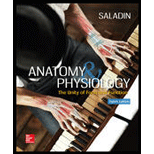
To discuss:
Components of the lacrimal apparatus and the route taken by tears as they wash over the eye and drain into the nasal cavity.
Introduction:
The perception of items that are present in the surroundings is termed as sight or vision. This perception occurs by means of reflection or emission of light from those objects. The retina, the neural component, is one of the principle components of the eyeball. It consists of three cell layers, and these cell layers are composed of ganglion cells, bipolar cells, and photoreceptor cells. The photoreceptor cells are involved in the absorption of light and produce a chemical or an electrical signal. These cells are of three kinds, namely cones, rods, and some ganglion cells. These cone and rod cells generate visual images, and these cells are related to ependymal cells located in the brain.
Want to see the full answer?
Check out a sample textbook solution
Chapter 16 Solutions
Anatomy & Physiology: The Unity of Form and Function
- How the ability to hear relies on vibrationarrow_forwardAll of the following except the nerve begin or end in the orbit.a. opticb. oculomotorc. trochleard. abducense. accessoryarrow_forwardAuditory receptors, are known as hair cells in which of the following?A. In the auditory nerveB. Along the basilar membrane of the cochleaC. Between the incus and the stapesD. In the pinnaarrow_forward
- Another function of the middle ear is to protect the inner ear from intesne sounds. This phenomenon is called the stapedial reflex, and results in the attenuation (decrease) of sound pressure reaching the inner ear. this reflex is consensual, which means that it....arrow_forwardA tumor has destroyed the areas of a patient’s thalamus that are part of the special senses pathways. Which special sensewill not be affected, and why? Explain why the patient has no conscious awareness of the remaining special sensesarrow_forwardWhich of the following is clearly visible when viewing the ventral aspect of the brain Transerve fissure, hypothalamus, central sulcus, olfactory bulbs or corpus callosumarrow_forward
- A sensorineural hearing loss results from impairment of which structure?a) Mobility of bony ossiclesb) First cranial nervec) Patency of external canald) Eighth cranial nervearrow_forwardTrue or false and why.According to the Labeled Line Principle, a receptor such as the nociceptor will be equallysensitive to both pain and temperature when stimulated.arrow_forwardReflex arcs and pain pathwaysarrow_forward
- The two-element sensory receptors differ from other types of receptors in being:-a- more numerousb- more widely spread in the bodyc- more sensitived- composed of specialized cells at the sensory nerve terminalsarrow_forwardtrue or false ..Fluent aphasic speakers generally have good deficit awareness; however, they may not be able to self-correct due to motor speech issues.arrow_forwardA 61-year-old woman has had difficulty hearing since having a cerebral infarction 1 day ago. Physical examination shows difficulty locating sounds on the right whenthe sound is presented to both ears The most likelv cause is a cerebral infarction involving which of the following structures on the left?A) Inferior temporal gyrusB) Lateral geniculate nucleusC) Medial geniculate nucleusD) Middle temporal gyrusE) Pulvinararrow_forward
- Understanding Health Insurance: A Guide to Billin...Health & NutritionISBN:9781337679480Author:GREENPublisher:Cengage

